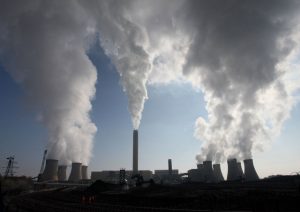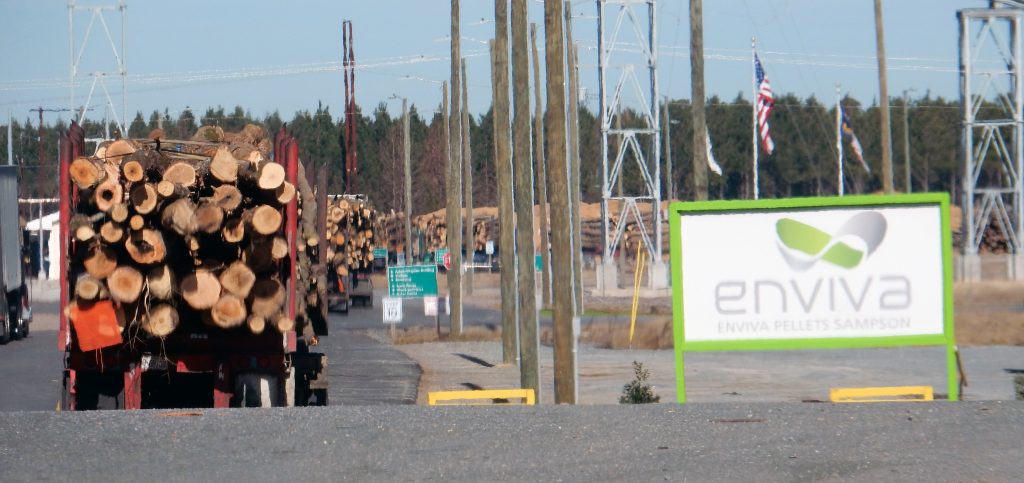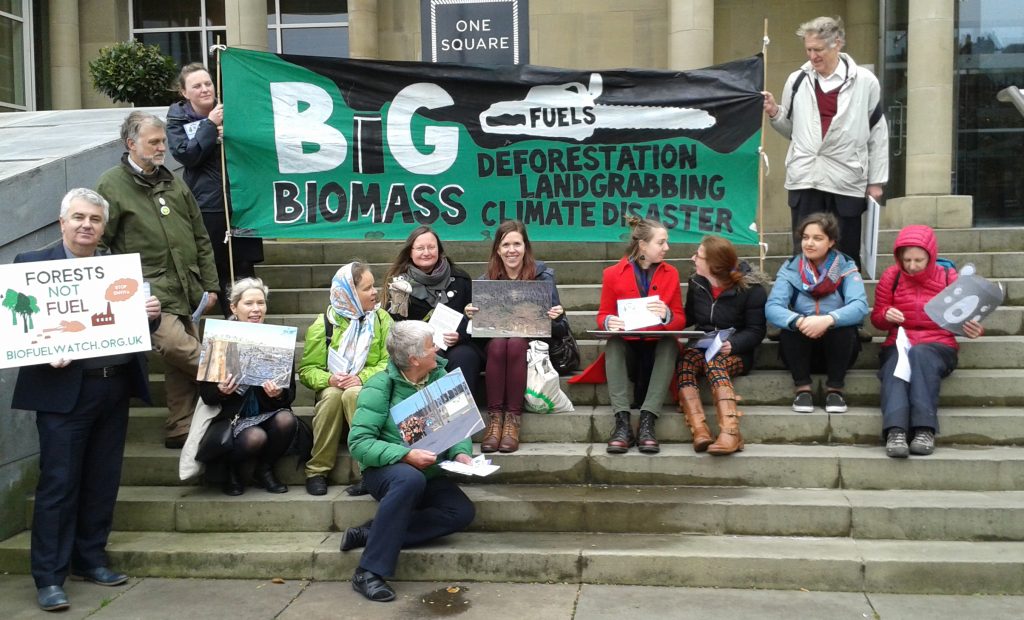What are the problems with big biomass?

Drax Power Station, North Yorkshire. Photo cc-by-sa/2.0 – © Andrew Whale – geograph.org.uk/p/2328563
In a nutshell – there are three problems:
1) It takes huge areas of land and huge quantities of wood to supply a tiny fraction of the energy we use.
2) Burning biomass emits CO2 to the atmosphere, just as burning fossil fuels does. Those emissions are ignored in governments’ and thus energy companies’ carbon accounting – yet the science increasingly shows that this is a dangerous omission and that cutting down trees for energy raises carbon in the atmosphere precisely when we need to rapidly reduce it to have any hope of keeping global warming to 1.5 degrees.
3) Burning biomass causes just as much harmful – and for some deadly – air pollution as burning coal.
1. Lots of land and wood for hardly any energy:
In 2021, Drax Power Station burned pellets made from at least 16.6 million tonnes of wood2, with one tonne of pellets requiring around 2 tonnes of green wood[/note]. This is the equivalent of 155% of the UK’s total wood production that year.4
Even if all that wood had been burned in a combined heat and power plant achieving twice the overall efficiency as Drax does, it would still have met a mere 1.9% of the UK energy’s demand.
The reason why biomass has a huge land footprint is that plants are very inefficient at converting energy from the sun into chemical energy. Forests and other ecosystems constantly recycle carbon, nitrogen and many other nutrients. Only a small proportion of the solar radiation that falls on a leaf is used to sequester carbon in trees and soils . Even worse, the amount of energy contained in biomass that is converted to electricity in a power station is miniscule once we compare it to all the energy that goes into building a power station, maintaining and logging tree plantations, chipping wood or turning it into pellets, transporting it, and then burning it at 35% efficiency or less in most biomas power stations.
Biomass electricity is the least efficient way of using land to produce (renewable) energy – by a long stretch!
Here is a representation of the amount of energy which solar PV can generate from one hectare of land in the UK compared to the amount of energy contained in the annual growth of UK conifer plantations on one hectare. Note that the solar PV figure is very conservative and lower than what has been reported from projects in England. If one looks at the actual amount of electricity generated from biomass versus solar PV from one hectare of land, the figures are even worse for biomass.
If one looks at the actual amount of electricity generated from biomass versus solar PV from one hectare of land, the figures are even worse for biomass.
No, forestry and sawmill residues are not the answer:
Energy companies and pellet producers like to tell us that they are using “residues” for their woodchips and pellets – even if photos show truck after truck of whole logs entering the pellet plant or woodchip mill.

A truck full of whole logs entering one of Enviva’s wood processing facilities. Photo by Dogwood Alliance
A key reason why companies are getting away with claiming they burn ‘residues’ when photos and videos clearly show them using roundwood is the vague definition of that term. Therere is no univesal definition of ‘forest residues’. Certainly in the EU and UK, any type and amount of roundwood can be classed as a ‘residue’ provided there is no competing demand from sawmills. Thus, once the demand of sawmills has been met, all other trees cut down become a ‘residue’. This is discussed in a Biofuelwatch report. 5
Even if only genuine logging residues, i.e. branches and twigs left behind after logging, were collected and burned, this would still be harmful to forests and climate. Removing all or most such residues depletes forest soils and results in them losing carbon and nutrients and in future trees growing less well. Removing deadwood from forests is especially harmful for wildlife and the resilience of forest ecosystems.6 Furthermore, a peer-reviewed study shows that burning US wood pellets that are made from genuine forestry residues will have a negative impact on carbon dioxide in the atmosphere for decades to come7.
Sawmill residues, on the other hand, are only available in limited quantities, which are fully utilised almost everywhere, including to make panelboard or paper.
2. No better for the climate than burning fossil fuels:
Burning biomass emits CO2 to the atmosphere, just as burning fossil fuels does. The upfront CO2 from burning wood are no less than those from burning coal per unit of energy. In smaller-and medium-sized biomass plants they can emit up to 50% more than emitted from larger coal plants, because smaller plants are less efficient and because woodchips in particular have a higher moisture content so more energy is needed to boil off the water. Governments and industry tell us that we can ignore all of those CO2 emissions because new trees will absorb them in future. But this is a dangerous and flawed assumption, for several reasons, as many studies and reports show8:
When trees are cut down for burning new ones will take decades to grow and absorb all the CO2 emitted again. At best, CO2 emitted from burning wood today still won’t be sequestered for at least a generation.
Forests sequester CO2 year on year, both in wood and other vegetation, and in soils. For a forestry company, logging the equivalent of the annual growth in trees every year appears “sustainable” because the volume of wood in a plantation or forest isn’t diminished.But for the climate, this means that forests will no longer sequester any CO2 at all. At present, around 30% of all the CO2 that humans emit, mainly from burning fossil fuels, is sequestered by plants. If less CO2 is sequestered in plants, more will stay in the atmosphere, fuelling warming.
The Paris Agreement commits Governments to trying to keep global warming to within 1.5ºC, but this will be impossible to achieve without a rapid phaseout of fossil fuel burning AND more CO2 being removed from the atmosphere. There is only one proven way of removing any CO2 from the atmosphere: Allowing natural ecosystems – including healthy soils – to flourish and regenerate, and helping restore them where necessary. If we want to have any hope of stabilising the climate, we need an end to fossil fuel burning as well allowing a lot more forests and other ecosystems to grow. Cutting down forests to replace some fossil fuels is completely the wrong answer.
If forests are replaced with tree plantations, CO2 will be lost to the atmosphere forever because tree plantations contain much less carbon than forest ecosystems;
Storing woodchips can emit significant amounts of methane, and those methane emissions are not accounted for by anybody9.
In February 2021, a letter signed by 500 scientists was presented to world leaders. It states: “regrowing trees and displacement of fossil fuels may eventually pay off this carbon debt, but regrowth takes time the world does not have to solve climate change. As numerous studies have shown, this burning of wood will increase warming for decades to centuries. That is true even when the wood replaces coal, oil or natural gas.”10 The European Acadamies’ Science Advisory Council has come to the same conclusion. 11
3. Similarly polluting as coal
Burning wood in power stations releases comparable level of air pollutants as burning coal. It emits less of some pollutants (especially sulphur dioxide and mercury) but more of others (especially fine particulates and Volatile Organic Compounds). Toxins emitted by biomass power plants are linked to respiratory and heart disease and strokes, and some are also linked to cancer and birth defects.
Processing wood to pellets or woodchips often emits a lot of wood dust. Communities exposed to wood dust report higher incidence of respiratory and nasal problems and, furthermore, wood dust is a known carcinogen.
Click here to read our briefing about air pollution from biomass power stations.

Where do the wood pellets burned in the UK come from? How much wood are we talking about?
Right now, there are two power stations burning wood pellets in the UK, all of them imported: Drax in Yorkshire and Lynemouth power station in Northumberland. As stated above, Drax burned 8.3 million tonnes of pellets made from twice as much wood in 2021. 61% those pellets came from the southern US, 22% from Canada, 11% from the Baltic States and most of the rest from Brazil, Portugal, Belarus and Russia 12. Supplies from Russia and possibly Belarus will now have beeen replaced by increased pellet imports from elsewhere.
Lynemouth Power station was converted to run on wood pellets by the Czech company EPH – it had previously been mothballed as a coal power plant. It has been burning around 1.5 million tonnes of pellets a year from the Southeastern USA, Canada,the Baltic States, Finland, Sweden, Russia and Portugal.
At Tees Port, MGT Power (owned by Macquarie Group and the Danish pension fund PKA)wants to open the world’s largest dedicated biomass power station. If this power station becomes operational, it will also burn over million tonnes of imported wood pellets a year, likely all or most of them from the Southeastern USA. The plant has been under construction since 2016 and, as of September 2022, is still not operational.
All other biomass power plants in the UK burn domestic biomass, mostly woodchips from UK tree plantations. According to the Forestry Commission, 1.9 million tonnes of roundwood were burned for energy in 2020.13 Burning UK conifers for energy is estimated to result in 80% greater impacts on CO2 levels than burning coal over a period of 20 years.14
For more information about Drax Plc, click here.
Also, see the Biomass FAQs by the Environmental Paper Network’s Biomass Working Group here and this series of Myth Buster reports by Dogwood Alliance here.
- Tonnes of wood refers to tonnes of green wood, which is the weight of freshly cut wood. Drax burned 8.3 million tonnes of pellets in 20211(https://www.drax.com/wp-content/uploads/2022/03/Drax_AR2021_2022-03-07.final_.pdf)
- Total UK wood production in 2021 was 10.7 million tonnes: https://www.forestresearch.gov.uk/tools-and-resources/statistics/forestry-statistics/note]. Burning more than 1.5 times the UK’s total annual wood production supplied a mere 0.95% of recent final energy use in the UK!3 Drax generated 14.81 TWh of electricity from burning wood in 2021 (https://www.drax.com/wp-content/uploads/2022/03/Drax_AR2021_2022-03-07.final_.pdf). UK final energy demand in 2021, was 134.1 million toe, which is 1,559.6 TWh. (https://assets.publishing.service.gov.uk/government/uploads/system/uploads/attachment_data/file/1094629/DUKES_2022.pdf)
- https://www.biofuelwatch.org.uk/2020/residues-briefing/
- https://www.biofuelwatch.org.uk/2020/polish-scientists-letter/
- Not carbon neutral: Assessing the net emissions impact of residues burned for bioenergy, Mary S Booth 2018 Environ. Res. Lett. 13 035001, iopscience.iop.org/article/10.1088/1748-9326/aaac88/pdf
- See biofuelwatch.org.uk/biomass-resources/resources-on-biomass/ for a list of relevant scientific studies and reports.
- How certain are greenhouse gas reductions from bioenergy? Life cycle assessment and uncertainty analysis of wood pellet-to-electricity supply chains from forest residues, Mirjam Röder et.al., Biomass and Bioenergy, August 2015
- https://www.woodwellclimate.org/letter-regarding-use-of-forests-for-bioenergy/
- easac.eu/fileadmin/PDF_s/reports_statements/Carbon_Neutrality/EASAC_commentary_on_Carbon_Neutrality_15_June_2018.pdf
- https://www.drax.com/wp-content/uploads/2022/03/Drax_AR2021_2022-03-07.final_.pdf
- https://www.forestresearch.gov.uk/tools-and-resources/statistics/forestry-statistics/
- ww2.rspb.org.uk/Images/Searchinger_comments_on_bioenergy_strategy_SEPT_2012_tcm9-329780.pdf
